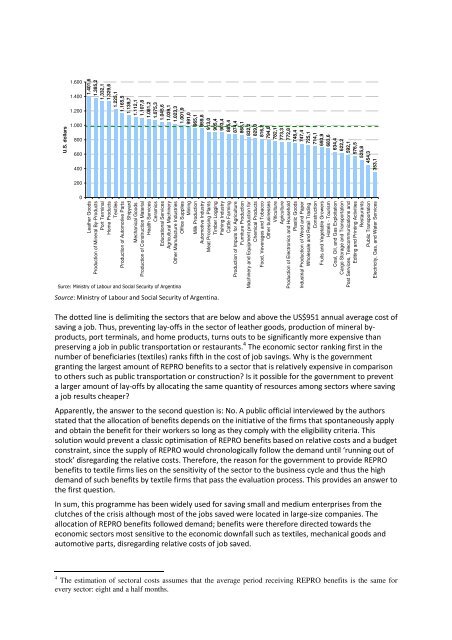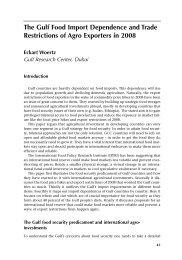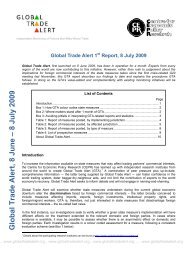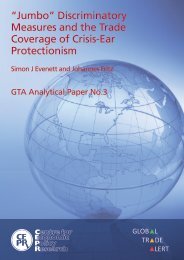GTA-AP7 Trucco.pdf - Global Trade Alert
GTA-AP7 Trucco.pdf - Global Trade Alert
GTA-AP7 Trucco.pdf - Global Trade Alert
- No tags were found...
You also want an ePaper? Increase the reach of your titles
YUMPU automatically turns print PDFs into web optimized ePapers that Google loves.
U.S. dollars1.6001.4001.2001.0008006004001.401,61.385,21.332,11.329,61.225,11.165,51.139,71.112,11.107,81.081,21.075,31.045,61.039,11.023,31.001,9991,0965,1959,8913,0905,4903,4885,4874,4868,1832,2829,0816,2794,0782,1773,3772,8748,4747,4725,1714,1693,9683,6634,4622,2592,1576,5525,8454,3353,12000Leather GoodsProduction of Mineral By-ProductsPort TerminalHome ProductsTextilesProduction of Automotive PartsShipyardMechanical GoodsProduction of Construction MaterialHealth ServicesCeramicsEducational ServicesAgricultural MachineryOther Manufacture IndustriesOffice SuppliesMiningMilk ProductionAutomotive IndustryMeat Processing PlantsTimber LoggingFishing IndustryCattle FarmingProduction of Imputs for AgricultureFurniture ProductionMachinery and Equipment production forChemical ProductsFood, Veverages and TobaccoOther businessesViticultureAgricultureProduction of Electronics and HouseholdPlastic GoodsIndustrial Production of Wood and PaperWholesale and Retail TradingConstructionFruits and Vegetable GrowersHotels - TourismCoal, Oil, and Gas ExploitationCargo Storage and TransportationPost Services, Telecommunications andEditing and Printing ActivitiesRestaurantsPublic TransportationElectricity, Gas, and Water ServicesSurce: Ministry of Labour and Social Security of ArgentinaSource: Ministry of Labour and Social Security of Argentina.The dotted line is delimiting the sectors that are below and above the US$951 annual average cost ofsaving a job. Thus, preventing lay-offs in the sector of leather goods, production of mineral byproducts,port terminals, and home products, turns outs to be significantly more expensive thanpreserving a job in public transportation or restaurants. 4 The economic sector ranking first in thenumber of beneficiaries (textiles) ranks fifth in the cost of job savings. Why is the governmentgranting the largest amount of REPRO benefits to a sector that is relatively expensive in comparisonto others such as public transportation or construction? Is it possible for the government to preventa larger amount of lay-offs by allocating the same quantity of resources among sectors where savinga job results cheaper?Apparently, the answer to the second question is: No. A public official interviewed by the authorsstated that the allocation of benefits depends on the initiative of the firms that spontaneously applyand obtain the benefit for their workers so long as they comply with the eligibility criteria. Thissolution would prevent a classic optimisation of REPRO benefits based on relative costs and a budgetconstraint, since the supply of REPRO would chronologically follow the demand until ‘running out ofstock’ disregarding the relative costs. Therefore, the reason for the government to provide REPRObenefits to textile firms lies on the sensitivity of the sector to the business cycle and thus the highdemand of such benefits by textile firms that pass the evaluation process. This provides an answer tothe first question.In sum, this programme has been widely used for saving small and medium enterprises from theclutches of the crisis although most of the jobs saved were located in large-size companies. Theallocation of REPRO benefits followed demand; benefits were therefore directed towards theeconomic sectors most sensitive to the economic downfall such as textiles, mechanical goods andautomotive parts, disregarding relative costs of job saved.4 The estimation of sectoral costs assumes that the average period receiving REPRO benefits is the same forevery sector: eight and a half months.









